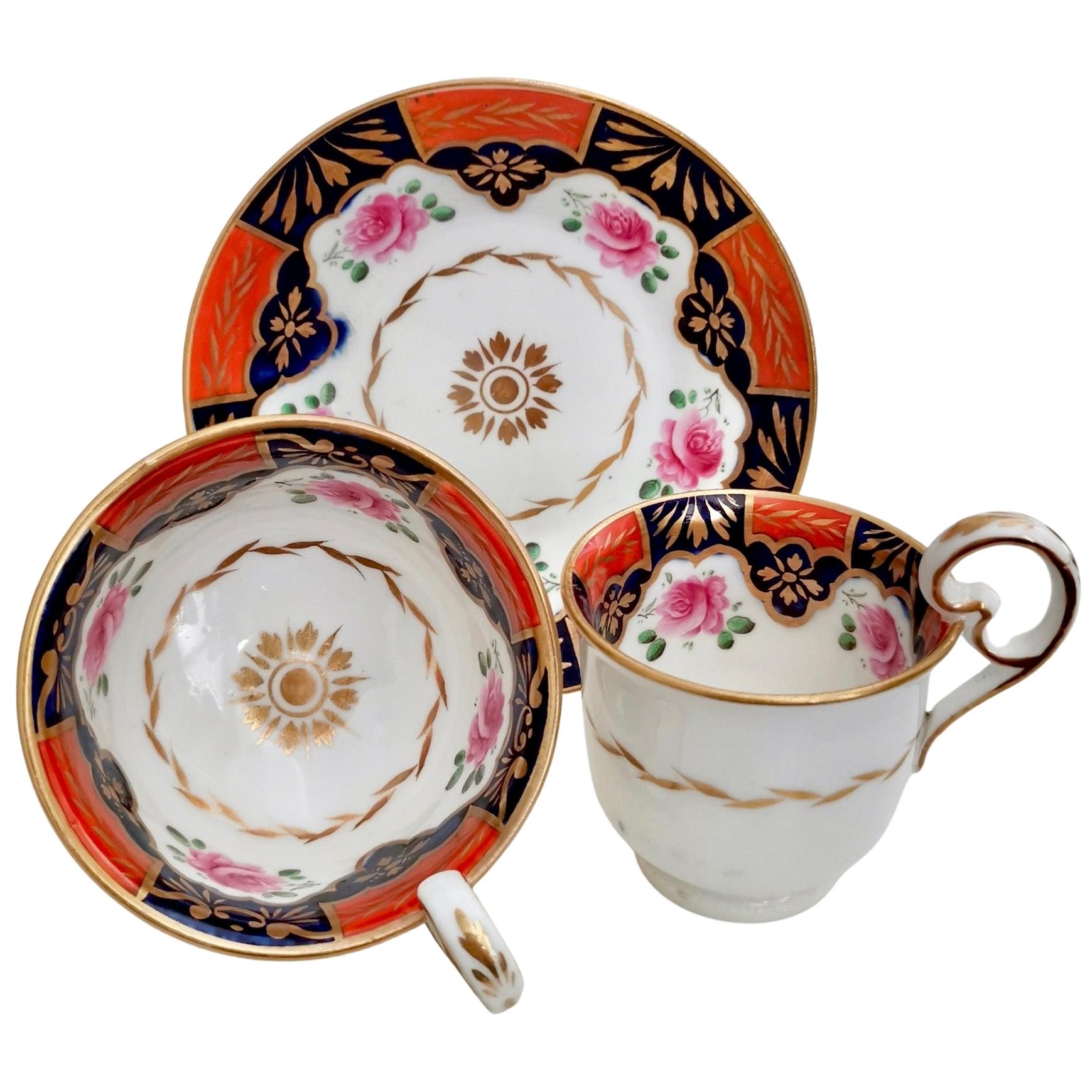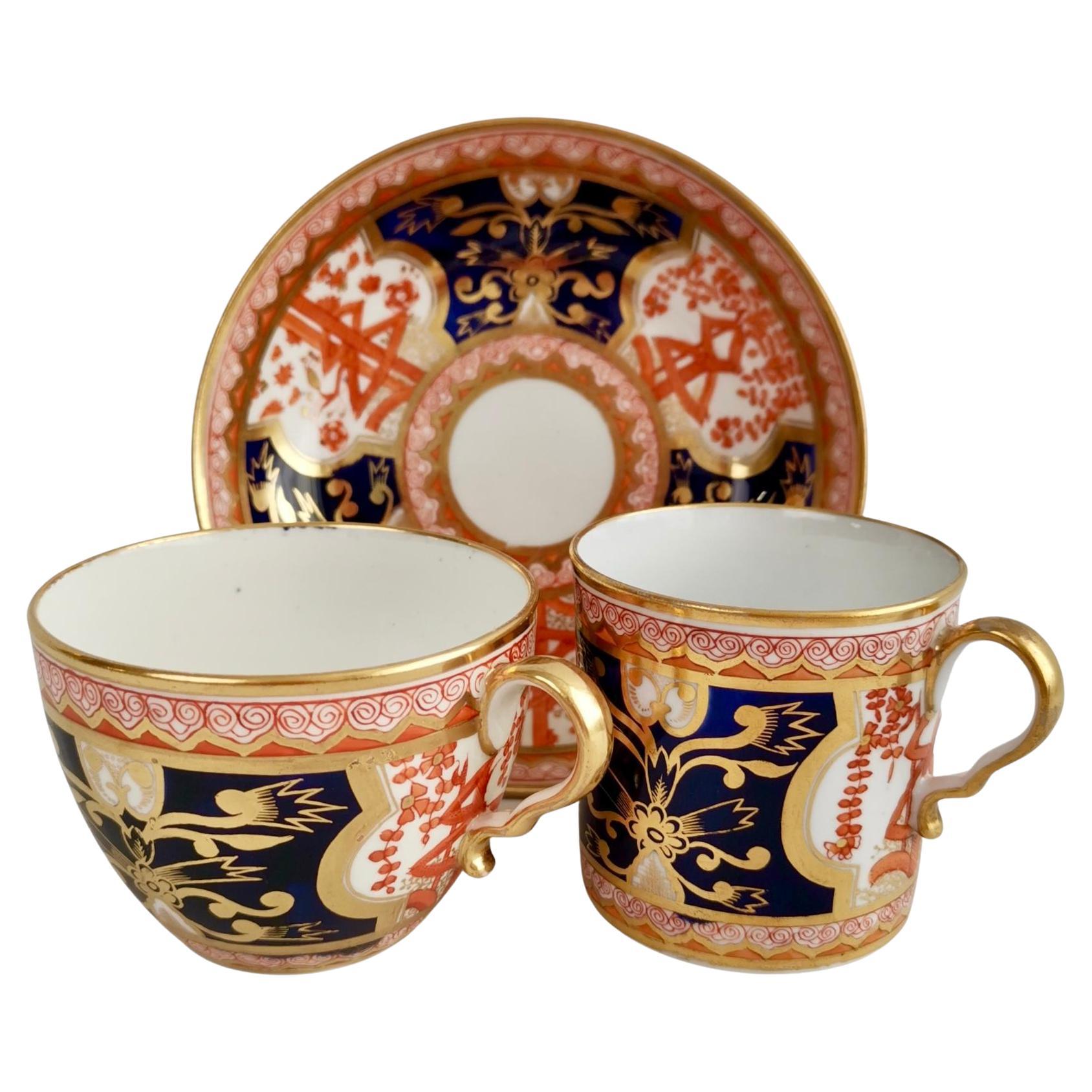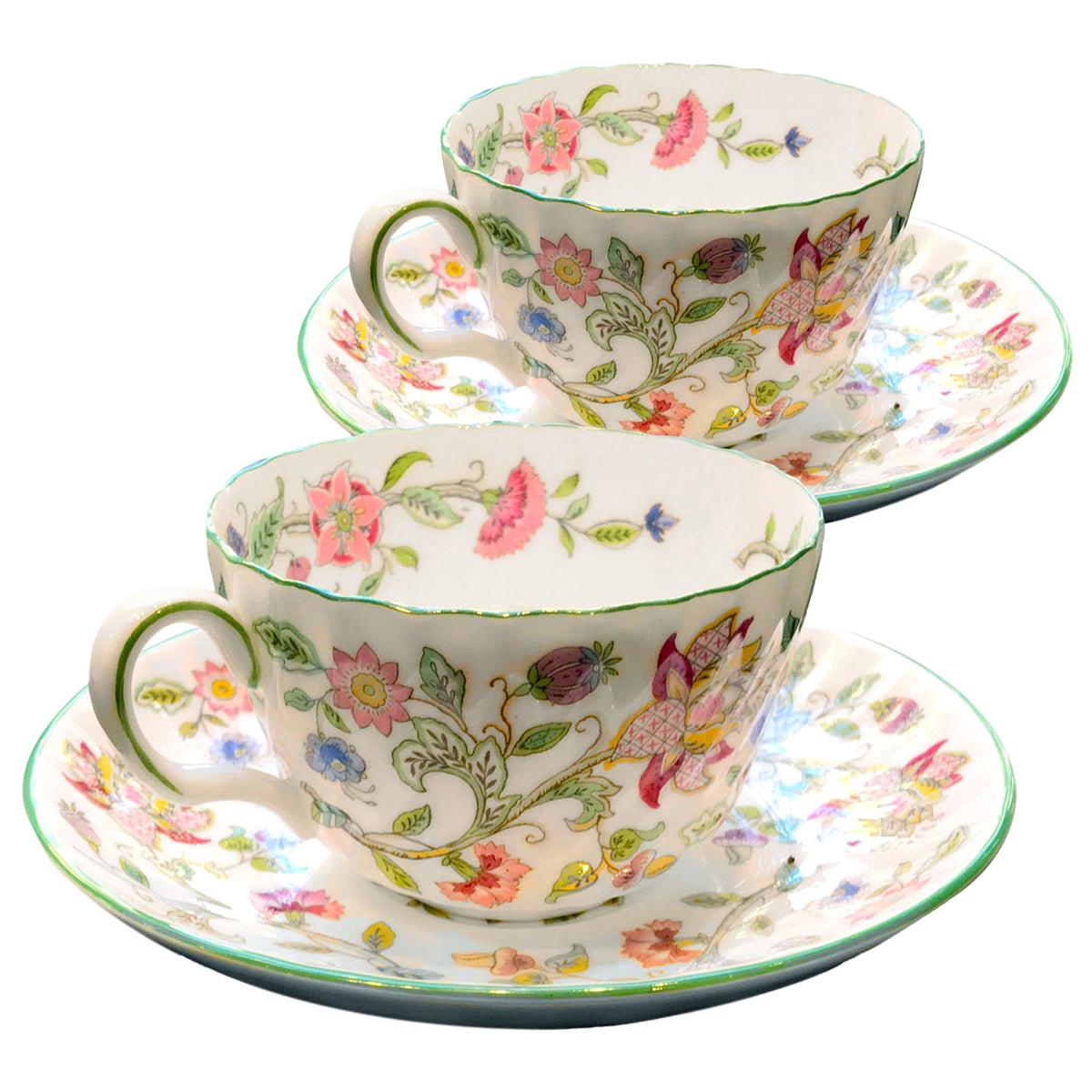Minton Porcelain Teacup Trio, Bath Embossed White with Sepia Roses, Regency 1830
About the Item
- Creator:Minton (Maker)
- Dimensions:Height: 1 in (2.54 cm)Diameter: 1 in (2.54 cm)
- Sold As:Set of 3
- Style:Regency (Of the Period)
- Materials and Techniques:
- Place of Origin:
- Period:
- Date of Manufacture:circa 1830
- Condition:Wear consistent with age and use. In excellent antique condition without any damage, repairs or crazing and hardly any wear.
- Seller Location:London, GB
- Reference Number:
Minton
Pottery is one of the oldest decorative art forms, and Minton is one of its historical masters. For more than 250 years, the English company was a premier producer of porcelain and ceramic wares. Its factory was known for detailed and brightly colored Victorian tableware, including dinner plates and serving pieces.
Thomas Minton founded the Minton factory in 1793 in Stoke-upon-Trent, England. It initially made earthenware but introduced bone china in 1798. When Minton died in 1836, the company passed to his son, Herbert Minton. The younger Minton was a savvy businessman with an eye for design. He introduced glossy majolica earthenware to the factory’s repertoire and hired skilled artists and designers like Augustus Welby Northmore Pugin and Albert-Ernest Carrier-Belleuse, boosting the company’s reputation.
In 1851, Minton debuted its majolica at the Great Exhibition in London. It became a royal family favorite and was even used to tile the Royal Dairy at Windsor Home Park. Minton majolica was also displayed on the monumental Saint George and the dragon fountain at the 1862 London International Exhibition.
Colin Minton Campbell, a nephew of Herbert Minton, took over the family business in 1858. He led the company to the head of the 1870s English art pottery movement. In the 1890s, French porcelain artist Marc-Louis Solon helped modernize Minton with his Art Nouveau designs.
Minton ceased operating as an independent company when it merged with Royal Doulton Tableware Ltd. in 1968. It was the end of an era, but not the end of widespread appreciation for Minton ceramics.
In 1982, the ”English Majolica” exhibition at the Cooper Hewitt, Smithsonian Design Museum featured 75 Minton pieces. When the Metropolitan Museum of Art reopened its British Galleries in 2020, it included a display of three colorful Minton majolica bird sculptures. Minton pottery was also on display from September 2021 to January 2022, along with other English pottery, at the Bard Graduate Center’s ”Majolica Mania” exhibition.
On 1stDibs, find exquisite Minton serveware, decorative objects, wall decorations and more.
- ShippingRetrieving quote...Ships From: London, United Kingdom
- Return PolicyA return for this item may be initiated within 14 days of delivery.
- Coalport Porcelain Teacup Trio, Orange with Roses, Regency, circa 1820By Nantgarw China WorksLocated in London, GBOn offer is a beautiful and rare "true trio" made by Coalport in about 1820. The trio has a beautiful Regency shape with heart shaped handles. This pattern is unusual and very rare....Category
Antique 1820s Welsh Regency Tea Sets
MaterialsPorcelain
- Spode Porcelain Teacup Trio, Lavender Blue with Flower Sprays, Regency ca 1815By SpodeLocated in London, GBThis is a beautiful "true trio" consisting of a teacup, a coffee cup and a saucer, made by Spode in about 1815. It is decorated with pattern 2234 with a striking lavender or periwinkle blue border and finely painted flower sprays. In the late 18th and early 19th Century a "true trio" is how cups and saucers were sold; as you would never drink tea and coffee at the same time, why invest in an extra saucer? Josiah Spode was the great pioneer among the Georgian potters in England. Around the year 1800 he perfected the bone china recipe that has been used by everyone ever since, and he was also the leading potter behind the technique of transferware, making it possible for English potters to replace the import of Chinese china that had come to an end around that time, with their own. This was fundamental to a thriving industry that would last for about 150 years and provide half the world with their tableware. This set is made in the famous "London" shape, which was brought out by Spode in 1812 and was quickly copied by all other makers. It then remained the most popular shape for about 10 years. The set is potted in fine white porcelain - by the year 1810 Spode had perfected his recipe for bone china and it became beautifully smooth, white, thin and translucent. All three items are marked with the red hand painted SPODE mark and the pattern number 2234. CONDITION REPORT The set is in excellent antique condition without any damage, repairs or crazing. There is some minimal wear as visible in the pictures...Category
Antique 1810s English Regency Porcelain
MaterialsPorcelain
- Spode Porcelain Teacup Trio, Red Imari Dollar Pattern, Regency, ca 1810By SpodeLocated in London, GBThis is a beautiful orphaned teacup made by Spode in about 1810. It bears a beautiful Japanese-inspired Imari pattern. Spode was the great pioneer among the Georgian potters in England. Around the year 1800 he perfected the bone china recipe that has been used by British potters ever since, and he was also the leading potter behind the technique of transferware, making it possible for English potters to replace the Chinese export china, which had come to an end around that time, with their own designs. This was fundamental to a thriving industry that would last for about 150 years and provide half the world with their tableware. Spode porcelain is regarded as one of the highest quality porcelains around; for a soft-paste porcelain it is surprisingly hard and fine, and has a wonderful bright white colour. The pattern on this can is called "Dollar" pattern, a very famous pattern that was used by English potters in the 18th and early 19th Century. It is obvious why it is called “dollar” - but its origin is less obvious! It is thought that this pattern was derived from a very old Chinese pattern depicting a tree with elaborate foliage that hides a Chinese character representing longevity or happiness. Traditionally, this went with a an image called “Taotie”, which was used on very ancient bronze vases...Category
Antique Early 1800s English Regency Porcelain
MaterialsPorcelain
- Derby Porcelain Teacup Trio, Green with Red Flowers, 1800-1810By DerbyLocated in London, GBThis is a wonderful "true trio" made by the Derby Porcelain factory between 1800 and 1810. The trio is decorated in an overglaze green ground with cheerful red flowers. In the late 18th and early 19th Century cups and saucers...Category
Antique Early 1800s English Regency Tea Sets
MaterialsPorcelain
- H&R Daniel Teacup Trio, White, Floral, Etruscan Shape, Regency circa 1825By H&R DanielLocated in London, GBThis is a rare and beautiful teacup trio made by H&R Daniel in about 1825. The set is potted in the "Etruscan" shape and is decorated in a white ground with a beautiful floral pattern and gilt anthemion sprigs. The trio consists of a teacup, a coffee cup and a saucer. In the 19th Century that's how cups and saucers were sold; as you would never drink tea and coffee at the same time, why invest in an extra saucer? We have a matching cake plate as well, please see separate listing. The H & R Daniel porcelain factory was founded by Henry Daniel, son of a family of master colour makers. He headed up the decoration department in the famous Spode factory where he oversaw all the beautiful early Spode decorations. In 1822 he opened his own factory with his son Richard, creating a truly iconic body of work with the most subtle colours and beautifully painted flowers and landscapes. The Daniel factory was the last true cottage industry among the English porcelain factories, resisting the increase of industrialisation and mass production. This resulted in extraordinary and unrivalled quality, but it probably also led to the factory having to close its doors in 1846 because it could no longer compete with others who did modernise. Daniel porcelain can be hard to identify as the factory was only around for about two decades, but this short duration and the low output also means that Daniel items have become true collectors' items. This set is potted in the "Etruscan" shape, a neoclassical shape with a strikingly angular handle and a graceful classical shape. The set is unmarked except the faded pattern number 3863 on the coffee cup, which points to a date of 1825. A picture of this pattern can be seen on plate 34 of Michael Berthoud and Lybne Price's "Daniel Patterns on Porcelain". CONDITION REPORT The set is in perfect antique condition except some very light rubbing as visible in the pictures. Antique British porcelain...Category
Antique 1820s English Rococo Revival Porcelain
MaterialsPorcelain
- New Hall Hybrid Hard Paste Teacup Trio, Elephant Pattern, Regency ca 1810By New HallLocated in London, GBThis is a beautiful true trio made by New Hall around the year 1810. The set is decorated in the very desired but rare Elephant pattern. A true trio is how cups and saucers were sol...Category
Antique 1810s English Regency Tea Sets
MaterialsPorcelain
- 12 Teacups and Saucers Minton Bone China Porcelain Haddon HallBy MintonLocated in Paris, FRSet of 12 teacups and with their saucers in Minton Bone China Porcelain. Famous Minton Haddon Hall model designed by John William Wadsworth (1879–19...Category
Early 20th Century English Porcelain
MaterialsPorcelain
- 12 Teacups and Saucers Minton Bone China Porcelain Haddon HallBy MintonLocated in Paris, FRSet of 12 teacups and with their saucers in Minton Bone China Porcelain. Famous Minton Haddon Hall model designed by John William Wadsworth (1879-19...Category
Early 20th Century English Porcelain
MaterialsPorcelain
- Set of Six Porcelain Bird Teacup TriosBy Flight, Barr & Barr WorcesterLocated in New York, NYSet of six porcelain bird teacup trios. Strikingly modern looking antique set of six BFB Worcester trios of six teacups and six coffee cups with six sh...Category
Antique Late 18th Century English Empire Tea Sets
MaterialsPorcelain
- Meissen Pink Rose. Two teacups with saucers and two plates in porcelain.Located in Copenhagen, DKMeissen Pink Rose. Two teacups with saucers and two plates in hand-painted porcelain with gold edge. Early 20th century. The cup measures: 8 x 4.5 c...Category
Early 20th Century German Porcelain
MaterialsPorcelain
- Four Antique Meissen Teacups with Saucers in Hand-Painted PorcelainLocated in Copenhagen, DKFour antique Meissen teacups with saucers in hand-painted porcelain. Purple flowers and gold decoration. Museum quality, approx. 1740. The cup meas...Category
Antique 1740s German Porcelain
MaterialsPorcelain
- Bjørn Wiinblad for Rosenthal, Lotus Porcelain Service, 9 Teacups with SaucersLocated in Copenhagen, DKBjørn Wiinblad for Rosenthal. Lotus porcelain service. 9 teacups with saucers decorated with pink lotus leaves. 1980s. The cup measures: 10 x 5 c...Category
Vintage 1980s German Modern Porcelain
MaterialsPorcelain






